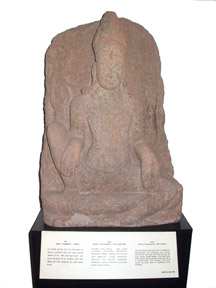Bharatha Natyam in ancient temple sculptures
Subashini Pathmanathan
One can easily notice most Sri Lankan sculptures are divided into
different categories. Some are stone-made sculptures, metal sculptures
including copper, gold, silver and five mixed metal sculptures which are
known as iyempon sculptures in Tamil. Even the stone sculptures are
further divided into granite stone sculptures, modern cement made
sculptures and marble sculptures.
| Influence of temple sculptures
* Sri Lankan sculptures are divided into different categories
* They last long
* Temple towers are full of sculptures
* According to Balasaraswathi Bharatha Natyam should follow the order of
temple architecture |
 |
|
Archeological and Hindu temple
sculptures of Sri Lanka play an important role in the field
of Bharatha Natyam |
These sculptures are long-lasting. However there are ivory
sculptures, wooden sculptures and clay sculptures available in the
ancient archeological sites and ancient temple sculptures. Bharatha
Natyam, which is the classical dance form of Tamil community all over
the world, derives its source from the Hinduism. Archeological and Hindu
temple sculptures of Sri Lanka play an important role in the field of
Bharatha Natyam.
These temple sculptures could be divided into different categories.
One is worshipping temple sculptures and the other is the temple
decorative sculptures which could be seen on the temple pillars, on the
rooftop sculptures, temple tower sculptures, carved in the temple wall
sculptures and temple pillar carved sculptures. The Hindu temples are
famous for tower sculptures referred to as temple Kopuram sculptures in
Tamil.
The tall kopurams (towers) of the temples are full of sculptures.
Within temples, on temple pillars, walls and rooftops there are plenty
of sculptures and in and around the mandapams and madams. Most temple
tower sculptures depict the puranic stories and epics related to the
main presiding deity of the temple. While the sculptures inside the
temples mainly depict the dance poses of various gods as well as humans.
Among all these temple sculptures, the most famous sculptures depict the
female dancing figures. Almost every Hindu temple structure all over the
world follows the South Indian temple structural architecture and style.
Even the Hindu temple architecture of Sri Lanka more or less follows the
Tamil Nadu and Andhra Hindu temple structure. According to Hinduism the
temple architectural pattern and structure should follow certain Hindu
Sastras and Agamas. Even the Bharatha Natyam repertoire also should
follow the same architectural structural order of Hindu temples.
The Bharatha Natyam queen late Balasarswathi said that the
fundamental basic order of a dance recital should follow the temple
architecture. According to Balasarswathi ‘the Bharatha Natyam recital is
structured like a great temple: enter through Gopuram (outer hall), the
Allarippu, cross through Arthamandapam, (halfway hall) the jetheeswaram,
then the mandapam, (the great hall), Sabtham, and the holy precinct of
the deity is Varnam’.
 |
|
The
sculptures last long |
The Indian Hindu temples as compared to Sri Lankan temples are quite
large. And these Indian Hindu temples have large corridors and have
fairly big temple art galleries. Bharatha Natyam is originated from the
temple Sathir, hence naturally it derived its soul and source from
temple sculptures. Some temple sculptures are only in standing
positions. Some sculptures are in full sitting positions, while another
set of sculptures are in half sitting positions. And these sculptures
have different body positions, neck positions, glances, hand positions,
hand gestures and stands, and foot positions.
Bharatha Natyam derives the sources for the costume patterns and the
designs from temple sculptures. Similarly different patterns of
ornaments for Bharatha Natyam are also derived from temple sculptural
ornaments. Ultimately one can come to the conclusion that temple
sculptures provide considerable amount of source for development of
Bharatha Natyam in general.
In Bharatha Natyam there are altogether 30 single hand gestures and
28 double hand gestures in use today. But the hand gestures used for the
temple sculptures are called sculptural hands. It is described in Tamil
as sitpa hands or kai Amaithi. But these hands almost resemble dance
hand gestures, but practically only a few sculptural hands are used in
Bharatha Natyam.
Same stands and postures of the same sculptural statues differ from
one era to another, and the whole sculptural statues also differ from
one area to another. One may predict these differences might occur due
to different influences of the different regimes, as well as the role
and the styles of the individual sculptural artistes.
These factors reveal individual imaginative creativity of each
sculptural artiste. That might vary from one another to certain extent,
without changing the basic Shastas and Agama traditions of the statues.
These must be the main responsible causes for the differences which
arise to analyse how the same sculptural images differ from one another
in different areas and different eras. The systematic analytical study
will help researchers understand the subject deeply.
|



